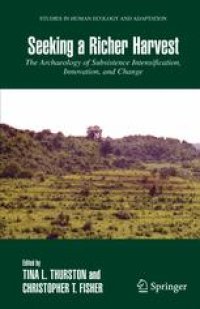
Ebook: Seeking a Richer Harvest: The Archaeology of Subsistence Intensification, Innovation, and Change
Author: Tina L. Thurston Christopher T. Fisher (auth.) Tina L. Thurston Christopher T. Fisher (eds.)
- Tags: Anthropology, Archaeology, Community & Population Ecology
- Series: Studies in Human Ecology and Adaptation 3
- Year: 2007
- Publisher: Springer US
- Edition: 1
- Language: English
- pdf
Subsistence intensification, innovation and change have long figured prominently in explanations for the development of social complexity among foragers and horticulturalists, and the rise of chiefly societies and archaic states, yet there is considerable debate over the actual mechanisms that promote these processes. Traditional approaches to the "intensification question" emphasize population pressure, climate change, bureaucratic management, or even land degradation as prerequisites for the onset of new or changing strategies, or the construction and maintenance of agricultural landscapes. Most often these factors are modeled as external forces outside the realm of human decision-making, but recent archaeological research presents an alternative to this suggesting that subsistence intensification is the result of human driven strategies for power, prestige and status stemming from internal conditions within a group. When responding to environmental adversity, human groups were less frequently the victims, as they have been repeatedly portrayed. Instead human groups were often vigorous actors, responding with resilience, ingenuity, and planning, to flourish or survive within dynamic and sometimes unpredictable social and natural milieux.
Subsistence intensification, innovation and change have long figured prominently in explanations for the development of social complexity among foragers and horticulturalists, and the rise of chiefly societies and archaic states, yet there is considerable debate over the actual mechanisms that promote these processes. Traditional approaches to the "intensification question" emphasize population pressure, climate change, bureaucratic management, or even land degradation as prerequisites for the onset of new or changing strategies, or the construction and maintenance of agricultural landscapes. Most often these factors are modeled as external forces outside the realm of human decision-making, but recent archaeological research presents an alternative to this suggesting that subsistence intensification is the result of human driven strategies for power, prestige and status stemming from internal conditions within a group. When responding to environmental adversity, human groups were less frequently the victims, as they have been repeatedly portrayed. Instead human groups were often vigorous actors, responding with resilience, ingenuity, and planning, to flourish or survive within dynamic and sometimes unpredictable social and natural milieux.
Subsistence intensification, innovation and change have long figured prominently in explanations for the development of social complexity among foragers and horticulturalists, and the rise of chiefly societies and archaic states, yet there is considerable debate over the actual mechanisms that promote these processes. Traditional approaches to the "intensification question" emphasize population pressure, climate change, bureaucratic management, or even land degradation as prerequisites for the onset of new or changing strategies, or the construction and maintenance of agricultural landscapes. Most often these factors are modeled as external forces outside the realm of human decision-making, but recent archaeological research presents an alternative to this suggesting that subsistence intensification is the result of human driven strategies for power, prestige and status stemming from internal conditions within a group. When responding to environmental adversity, human groups were less frequently the victims, as they have been repeatedly portrayed. Instead human groups were often vigorous actors, responding with resilience, ingenuity, and planning, to flourish or survive within dynamic and sometimes unpredictable social and natural milieux.
Content:
Front Matter....Pages i-x
Seeking a Richer Harvest....Pages 1-21
Classic Period Agricultural Intensification and Domestic Life at el Palmillo, Valley of Oaxaca, Mexico....Pages 23-61
The Wet or the Dry?....Pages 63-90
Agricultural Intensification in the Lake Patzcuaro Basin....Pages 91-106
Chinampa Cultivation in the Basin of Mexico....Pages 107-124
Agricultural Intensification in the Titicaca Basin....Pages 125-139
Animal Intensification at Neolithic Gritille....Pages 141-153
Infields, Outfields, and Broken Lands....Pages 155-191
Cod Fish, Walrus, and Chieftains....Pages 193-216
Intensification and Protohistoric Agropastoral Systems in East Africa....Pages 217-233
Rethinking Intensification....Pages 235-247
Intensification, Innovation, and Change....Pages 249-259
Back Matter....Pages 261-273
Subsistence intensification, innovation and change have long figured prominently in explanations for the development of social complexity among foragers and horticulturalists, and the rise of chiefly societies and archaic states, yet there is considerable debate over the actual mechanisms that promote these processes. Traditional approaches to the "intensification question" emphasize population pressure, climate change, bureaucratic management, or even land degradation as prerequisites for the onset of new or changing strategies, or the construction and maintenance of agricultural landscapes. Most often these factors are modeled as external forces outside the realm of human decision-making, but recent archaeological research presents an alternative to this suggesting that subsistence intensification is the result of human driven strategies for power, prestige and status stemming from internal conditions within a group. When responding to environmental adversity, human groups were less frequently the victims, as they have been repeatedly portrayed. Instead human groups were often vigorous actors, responding with resilience, ingenuity, and planning, to flourish or survive within dynamic and sometimes unpredictable social and natural milieux.
Content:
Front Matter....Pages i-x
Seeking a Richer Harvest....Pages 1-21
Classic Period Agricultural Intensification and Domestic Life at el Palmillo, Valley of Oaxaca, Mexico....Pages 23-61
The Wet or the Dry?....Pages 63-90
Agricultural Intensification in the Lake Patzcuaro Basin....Pages 91-106
Chinampa Cultivation in the Basin of Mexico....Pages 107-124
Agricultural Intensification in the Titicaca Basin....Pages 125-139
Animal Intensification at Neolithic Gritille....Pages 141-153
Infields, Outfields, and Broken Lands....Pages 155-191
Cod Fish, Walrus, and Chieftains....Pages 193-216
Intensification and Protohistoric Agropastoral Systems in East Africa....Pages 217-233
Rethinking Intensification....Pages 235-247
Intensification, Innovation, and Change....Pages 249-259
Back Matter....Pages 261-273
....